Σύνδεση
Αναζήτηση
Πρόσφατα Θέματα
Παρόντες χρήστες
1 χρήστης είναι συνδεδεμένος αυτήν την στιγμή:: 0 μέλη, 0 μη ορατοί και 1 επισκέπτης Κανένας
Περισσότεροι χρήστες υπό σύνδεση 28, στις Τετ Ιαν 25, 2017 1:10 am
Clock
Astronomy Picture of the Day
Σελίδα 10 από 15
Σελίδα 10 από 15 •  1 ... 6 ... 9, 10, 11 ... 15
1 ... 6 ... 9, 10, 11 ... 15 
 2017 July 31
2017 July 31
2017 July 31
Pluto Flyover from New Horizons
Credit: NASA, JHUAPL, SwRI, P. Schenk & J. Blackwell (LPI); Music Open Sea Morning by Puddle of Infinity
Explanation: What if you could fly over Pluto -- what might you see? The New Horizons spacecraft did just this in 2015 July as it shot past the distant world at a speed of about 80,000 kilometers per hour. Recently, many images from this spectacular passage have been color enhanced and digitally combined into the featured two-minute time-lapse video. As your journey begins, light dawns on mountains thought to be composed of water ice but colored by frozen nitrogen. Soon, to your right, you see a flat sea of mostly solid nitrogen that has segmented into strange polygons that are thought to have bubbled up from a comparatively warm interior. Craters and ice mountains are common sights below. The video dims and ends over terrain dubbed bladed because it shows 500-meter high ridges separated by kilometer-sized gaps. Although the robotic New Horizons spacecraft has too much momentum ever to return to Pluto, it has now been targeted at Kuiper Belt object 2014 MU 69, which it should shoot past on New Year's Day 2019.
Pluto Flyover from New Horizons
Credit: NASA, JHUAPL, SwRI, P. Schenk & J. Blackwell (LPI); Music Open Sea Morning by Puddle of Infinity
Explanation: What if you could fly over Pluto -- what might you see? The New Horizons spacecraft did just this in 2015 July as it shot past the distant world at a speed of about 80,000 kilometers per hour. Recently, many images from this spectacular passage have been color enhanced and digitally combined into the featured two-minute time-lapse video. As your journey begins, light dawns on mountains thought to be composed of water ice but colored by frozen nitrogen. Soon, to your right, you see a flat sea of mostly solid nitrogen that has segmented into strange polygons that are thought to have bubbled up from a comparatively warm interior. Craters and ice mountains are common sights below. The video dims and ends over terrain dubbed bladed because it shows 500-meter high ridges separated by kilometer-sized gaps. Although the robotic New Horizons spacecraft has too much momentum ever to return to Pluto, it has now been targeted at Kuiper Belt object 2014 MU 69, which it should shoot past on New Year's Day 2019.

panosol- Αριθμός μηνυμάτων : 762
Points : 927
Reputation : 15
Ημερομηνία εγγραφής : 17/06/2012
Ηλικία : 56
 2017 August 1
2017 August 1
2017 August 1

Perseid Meteors over Turkey
Image Credit & Copyright: Tunç Tezel (TWAN)
Explanation: The Perseid Meteor Shower, usually the best meteor shower of the year, will peak late next week. A person watching a clear sky from a dark location might see a bright meteor every minute. These meteors are actually specks of rock that have broken off Comet Swift-Tuttle and continued to orbit the Sun until they vaporize in Earth's atmosphere. The featured composite image shows a outburst of Perseids as they appeared over Turkey during last year's meteor shower. Enough meteors were captured to trace the shower's radiant back to the constellation of Perseus on the far left. The tail-end of the Perseids will still be going during the total solar eclipse on August 21, creating a rare opportunity for some lucky astrophotographers to image a Perseid meteor during the day.

Perseid Meteors over Turkey
Image Credit & Copyright: Tunç Tezel (TWAN)
Explanation: The Perseid Meteor Shower, usually the best meteor shower of the year, will peak late next week. A person watching a clear sky from a dark location might see a bright meteor every minute. These meteors are actually specks of rock that have broken off Comet Swift-Tuttle and continued to orbit the Sun until they vaporize in Earth's atmosphere. The featured composite image shows a outburst of Perseids as they appeared over Turkey during last year's meteor shower. Enough meteors were captured to trace the shower's radiant back to the constellation of Perseus on the far left. The tail-end of the Perseids will still be going during the total solar eclipse on August 21, creating a rare opportunity for some lucky astrophotographers to image a Perseid meteor during the day.

panosol- Αριθμός μηνυμάτων : 762
Points : 927
Reputation : 15
Ημερομηνία εγγραφής : 17/06/2012
Ηλικία : 56
 2017 August 2
2017 August 2
2017 August 2
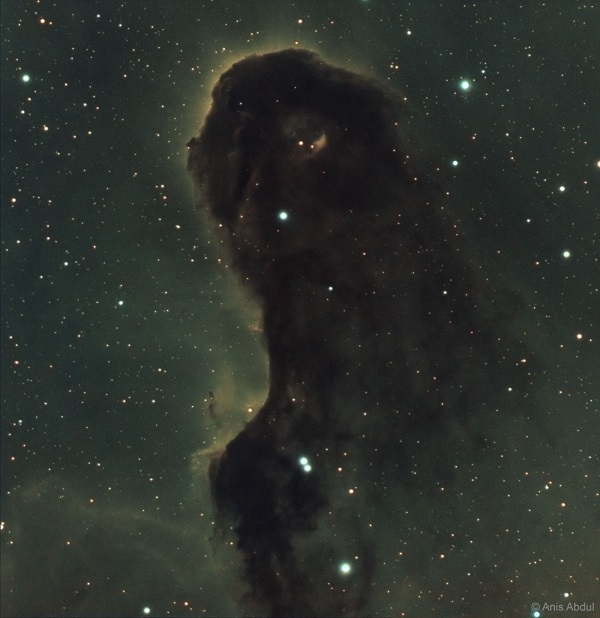
The Dust Monster in IC 1396
Image Credit & Copyright: Anis Abdul
Explanation: Is there a monster in IC 1396? Known to some as the Elephant's Trunk Nebula, parts of gas and dust clouds of this star formation region may appear to take on foreboding forms, some nearly human. The only real monster here, however, is a bright young star too far from Earth to hurt us. Energetic light from this star is eating away the dust of the dark cometary globule near the top of the featured image. Jets and winds of particles emitted from this star are also pushing away ambient gas and dust. Nearly 3,000 light-years distant, the relatively faint IC 1396 complex covers a much larger region on the sky than shown here, with an apparent width of more than 10 full moons.

The Dust Monster in IC 1396
Image Credit & Copyright: Anis Abdul
Explanation: Is there a monster in IC 1396? Known to some as the Elephant's Trunk Nebula, parts of gas and dust clouds of this star formation region may appear to take on foreboding forms, some nearly human. The only real monster here, however, is a bright young star too far from Earth to hurt us. Energetic light from this star is eating away the dust of the dark cometary globule near the top of the featured image. Jets and winds of particles emitted from this star are also pushing away ambient gas and dust. Nearly 3,000 light-years distant, the relatively faint IC 1396 complex covers a much larger region on the sky than shown here, with an apparent width of more than 10 full moons.

panosol- Αριθμός μηνυμάτων : 762
Points : 927
Reputation : 15
Ημερομηνία εγγραφής : 17/06/2012
Ηλικία : 56
 2017 August 3
2017 August 3
2017 August 3
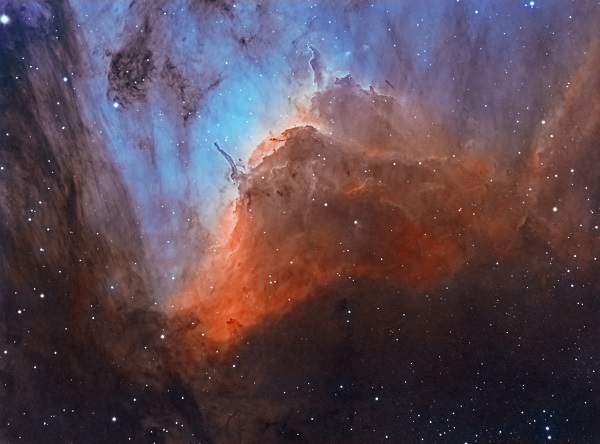
Pelican Nebula Close-up
Image Credit & Copyright: Sara Wager
Explanation: The prominent ridge of emission featured in this vivid skyscape is designated IC 5067. Part of a larger emission region with a distinctive shape, popularly called The Pelican Nebula, the ridge spans about 10 light-years and follows the curve of the cosmic pelican's head and neck. Fantastic, dark shapes inhabiting the view are clouds of cool gas and dust sculpted by energetic radiation from young, hot, massive stars. But stars are also forming within the dark shapes. Twin jets emerging from the tip of the long, dark tendril left of center are the telltale signs of an embedded protostar cataloged as Herbig-Haro 555 (HH 555). In fact, other Herbig-Haro objects indicating the presence of protostars are found within the frame. The Pelican Nebula itself, also known as IC 5070, is about 2,000 light-years away. To find it, look northeast of bright star Deneb in the high flying constellation Cygnus.

Pelican Nebula Close-up
Image Credit & Copyright: Sara Wager
Explanation: The prominent ridge of emission featured in this vivid skyscape is designated IC 5067. Part of a larger emission region with a distinctive shape, popularly called The Pelican Nebula, the ridge spans about 10 light-years and follows the curve of the cosmic pelican's head and neck. Fantastic, dark shapes inhabiting the view are clouds of cool gas and dust sculpted by energetic radiation from young, hot, massive stars. But stars are also forming within the dark shapes. Twin jets emerging from the tip of the long, dark tendril left of center are the telltale signs of an embedded protostar cataloged as Herbig-Haro 555 (HH 555). In fact, other Herbig-Haro objects indicating the presence of protostars are found within the frame. The Pelican Nebula itself, also known as IC 5070, is about 2,000 light-years away. To find it, look northeast of bright star Deneb in the high flying constellation Cygnus.

panosol- Αριθμός μηνυμάτων : 762
Points : 927
Reputation : 15
Ημερομηνία εγγραφής : 17/06/2012
Ηλικία : 56
 2017 August 4
2017 August 4
2017 August 4
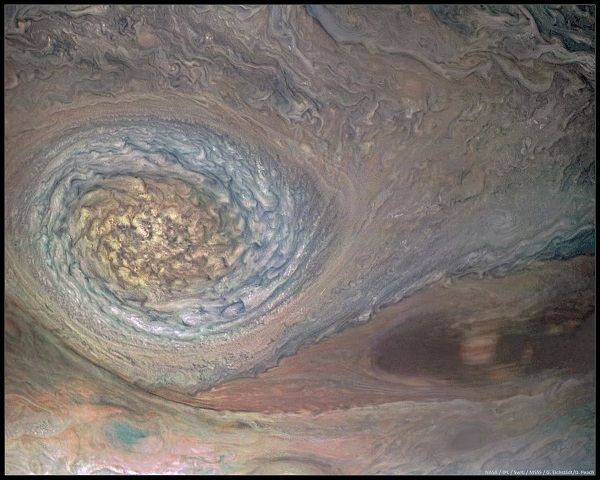
North North Temperate Zone Little Red Spot
Image Credit: NASA, JPL-Caltech, SwRI, MSSS; Processing: Gerald Eichstadt, Damian Peach
Explanation: On July 11, the Juno spacecraft once again swung near the turbulent Jovian cloud tops. On its seventh orbital closest approach this perijove passage brought Juno within 3,500 kilometers of the Solar System's largest planetary atmosphere. Near perijove the rotating JunoCam was able to record this stunning, clear view of one of Jupiter's signature vortices. About 8,000 kilometers in diameter, the anticyclonic storm system was spotted in Jupiter's North North Temperate Zone in the 1990s. That makes it about half the size of an older and better known Jovian anticyclone, the Great Red Spot, but only a little smaller than planet Earth. At times taking on reddish hues, the enormous storm system is fondly known as a North North Temperate Zone Little Red Spot.

North North Temperate Zone Little Red Spot
Image Credit: NASA, JPL-Caltech, SwRI, MSSS; Processing: Gerald Eichstadt, Damian Peach
Explanation: On July 11, the Juno spacecraft once again swung near the turbulent Jovian cloud tops. On its seventh orbital closest approach this perijove passage brought Juno within 3,500 kilometers of the Solar System's largest planetary atmosphere. Near perijove the rotating JunoCam was able to record this stunning, clear view of one of Jupiter's signature vortices. About 8,000 kilometers in diameter, the anticyclonic storm system was spotted in Jupiter's North North Temperate Zone in the 1990s. That makes it about half the size of an older and better known Jovian anticyclone, the Great Red Spot, but only a little smaller than planet Earth. At times taking on reddish hues, the enormous storm system is fondly known as a North North Temperate Zone Little Red Spot.

panosol- Αριθμός μηνυμάτων : 762
Points : 927
Reputation : 15
Ημερομηνία εγγραφής : 17/06/2012
Ηλικία : 56
 2017 August 5
2017 August 5
2017 August 5
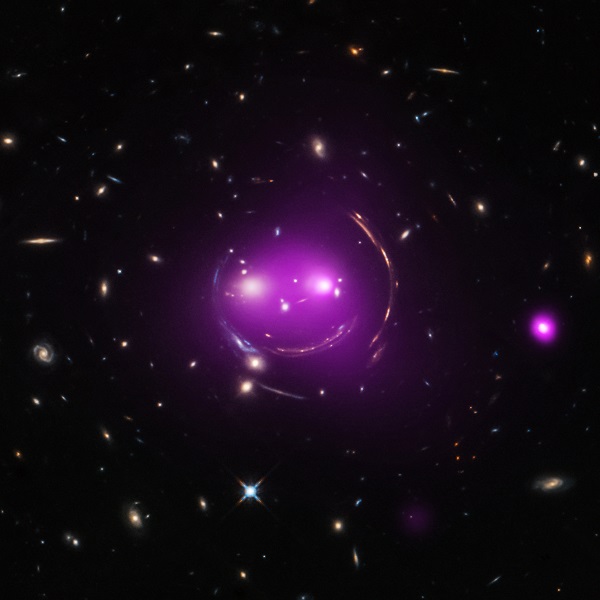
Gravity's Grin
Image Credit: X-ray - NASA / CXC / J. Irwin et al. ; Optical - NASA/STScI
Explanation: Albert Einstein's general theory of relativity, published over 100 years ago, predicted the phenomenon of gravitational lensing. And that's what gives these distant galaxies such a whimsical appearance, seen through the looking glass of X-ray and optical image data from the Chandra and Hubble space telescopes. Nicknamed the Cheshire Cat galaxy group, the group's two large elliptical galaxies are suggestively framed by arcs. The arcs are optical images of distant background galaxies lensed by the foreground group's total distribution of gravitational mass. Of course, that gravitational mass is dominated by dark matter. The two large elliptical "eye" galaxies represent the brightest members of their own galaxy groups which are merging. Their relative collisional speed of nearly 1,350 kilometers/second heats gas to millions of degrees producing the X-ray glow shown in purple hues. Curiouser about galaxy group mergers? The Cheshire Cat group grins in the constellation Ursa Major, some 4.6 billion light-years away.

Gravity's Grin
Image Credit: X-ray - NASA / CXC / J. Irwin et al. ; Optical - NASA/STScI
Explanation: Albert Einstein's general theory of relativity, published over 100 years ago, predicted the phenomenon of gravitational lensing. And that's what gives these distant galaxies such a whimsical appearance, seen through the looking glass of X-ray and optical image data from the Chandra and Hubble space telescopes. Nicknamed the Cheshire Cat galaxy group, the group's two large elliptical galaxies are suggestively framed by arcs. The arcs are optical images of distant background galaxies lensed by the foreground group's total distribution of gravitational mass. Of course, that gravitational mass is dominated by dark matter. The two large elliptical "eye" galaxies represent the brightest members of their own galaxy groups which are merging. Their relative collisional speed of nearly 1,350 kilometers/second heats gas to millions of degrees producing the X-ray glow shown in purple hues. Curiouser about galaxy group mergers? The Cheshire Cat group grins in the constellation Ursa Major, some 4.6 billion light-years away.

panosol- Αριθμός μηνυμάτων : 762
Points : 927
Reputation : 15
Ημερομηνία εγγραφής : 17/06/2012
Ηλικία : 56
 2017 August 6
2017 August 6
2017 August 6

Milky Way and Exploding Meteor
Image Credit & Copyright: André van der Hoeven
Explanation: Next weekend the Perseid Meteor Shower reaches its maximum. Grains of icy rock will streak across the sky as they evaporate during entry into Earth's atmosphere. These grains were shed from Comet Swift-Tuttle. The Perseids result from the annual crossing of the Earth through Comet Swift-Tuttle's orbit, and are typically the most active meteor shower of the year. Although it is hard to predict the level of activity in any meteor shower, in a clear dark sky an observer might see a meteor a minute. This year's Perseids peak nearly a week after full Moon, and so some faint meteors will be lost to the lunar skyglow. Meteor showers in general are best be seen from a relaxing position, away from lights. Featured here is a meteor caught exploding during the 2015 Perseids above Austria next to the central band of our Milky Way Galaxy.

Milky Way and Exploding Meteor
Image Credit & Copyright: André van der Hoeven
Explanation: Next weekend the Perseid Meteor Shower reaches its maximum. Grains of icy rock will streak across the sky as they evaporate during entry into Earth's atmosphere. These grains were shed from Comet Swift-Tuttle. The Perseids result from the annual crossing of the Earth through Comet Swift-Tuttle's orbit, and are typically the most active meteor shower of the year. Although it is hard to predict the level of activity in any meteor shower, in a clear dark sky an observer might see a meteor a minute. This year's Perseids peak nearly a week after full Moon, and so some faint meteors will be lost to the lunar skyglow. Meteor showers in general are best be seen from a relaxing position, away from lights. Featured here is a meteor caught exploding during the 2015 Perseids above Austria next to the central band of our Milky Way Galaxy.

panosol- Αριθμός μηνυμάτων : 762
Points : 927
Reputation : 15
Ημερομηνία εγγραφής : 17/06/2012
Ηλικία : 56
 2017 August 7
2017 August 7
2017 August 7
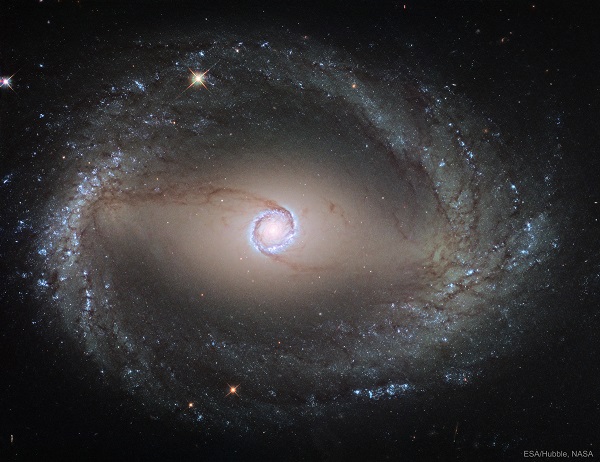
Spiral Galaxy NGC 1512: The Inner Ring
Image Credit: NASA, ESA, Hubble Space Telescope
Explanation: Most galaxies don't have any rings -- why does this galaxy have two? To begin, the bright band near NGC 1512's center is a nuclear ring, a ring that surrounds the galaxy center and glows brightly with recently formed stars. Most stars and accompanying gas and dust, however, orbit the galactic center in a ring much further out -- here seen near the image edge. This ring is called, counter-intuitively, the inner ring. If you look closely, you will see this the inner ring connects ends of a diffuse central bar that runs horizontally across the galaxy. These ring structures are thought to be caused by NGC 1512's own asymmetries in a drawn-out process called secular evolution. The gravity of these galaxy asymmetries, including the bar of stars, cause gas and dust to fall from the inner ring to the nuclear ring, enhancing this ring's rate of star formation. Some spiral galaxies also have a third ring -- an outer ring that circles the galaxy even further out.

Spiral Galaxy NGC 1512: The Inner Ring
Image Credit: NASA, ESA, Hubble Space Telescope
Explanation: Most galaxies don't have any rings -- why does this galaxy have two? To begin, the bright band near NGC 1512's center is a nuclear ring, a ring that surrounds the galaxy center and glows brightly with recently formed stars. Most stars and accompanying gas and dust, however, orbit the galactic center in a ring much further out -- here seen near the image edge. This ring is called, counter-intuitively, the inner ring. If you look closely, you will see this the inner ring connects ends of a diffuse central bar that runs horizontally across the galaxy. These ring structures are thought to be caused by NGC 1512's own asymmetries in a drawn-out process called secular evolution. The gravity of these galaxy asymmetries, including the bar of stars, cause gas and dust to fall from the inner ring to the nuclear ring, enhancing this ring's rate of star formation. Some spiral galaxies also have a third ring -- an outer ring that circles the galaxy even further out.

panosol- Αριθμός μηνυμάτων : 762
Points : 927
Reputation : 15
Ημερομηνία εγγραφής : 17/06/2012
Ηλικία : 56
 2017 August 8
2017 August 8
2017 August 8

Density Waves in Saturn's Rings from Cassini
Image Credit & License: NASA/JPL/SSI; Digital Composite : Emily Lakdawalla (Planetary Society)
Explanation: What causes the patterns in Saturn's rings? The Cassini spacecraft, soon ending its 13 years orbiting Saturn, has sent back another spectacular image of Saturn's immense ring system in unprecedented detail. The physical cause for some of Saturn's ring structures is not always understood. The cause for the beautifully geometric type of ring structure shown here in ring of Saturn, however, is surely a density wave. A small moon systematically perturbing the orbits of ring particles circling Saturn at slightly different distances causes such a density wave bunching. Also visible on the lower right of the image is a bending wave, a vertical wave in ring particles also caused by the gravity of a nearby moon. Cassini's final orbits are allowing a series of novel scientific measurements and images of the Solar System's most grand ring system.

Density Waves in Saturn's Rings from Cassini
Image Credit & License: NASA/JPL/SSI; Digital Composite : Emily Lakdawalla (Planetary Society)
Explanation: What causes the patterns in Saturn's rings? The Cassini spacecraft, soon ending its 13 years orbiting Saturn, has sent back another spectacular image of Saturn's immense ring system in unprecedented detail. The physical cause for some of Saturn's ring structures is not always understood. The cause for the beautifully geometric type of ring structure shown here in ring of Saturn, however, is surely a density wave. A small moon systematically perturbing the orbits of ring particles circling Saturn at slightly different distances causes such a density wave bunching. Also visible on the lower right of the image is a bending wave, a vertical wave in ring particles also caused by the gravity of a nearby moon. Cassini's final orbits are allowing a series of novel scientific measurements and images of the Solar System's most grand ring system.

panosol- Αριθμός μηνυμάτων : 762
Points : 927
Reputation : 15
Ημερομηνία εγγραφής : 17/06/2012
Ηλικία : 56
 2017 August 9
2017 August 9
2017 August 9
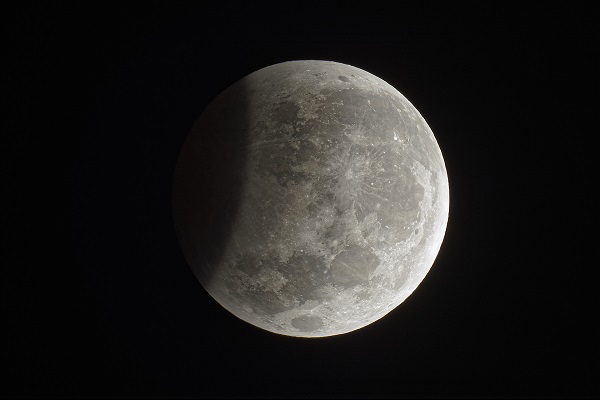
August's Lunar Eclipse
Peter Ward (Barden Ridge Observatory)
Explanation: August's Full Moon is framed in this sharp, high dynamic range composition. Captured before sunrise on August 8 from Sydney, Australia, south is up and the Earth's dark, umbral shadow is at the left, near the maximum phase of a partial lunar eclipse. Kicking off the eclipse season, this time the Full Moon's grazing slide through Earth's shadow was visible from the eastern hemisphere. Up next is the much anticipated total solar eclipse of August 21. Then, the New Moon's shadow track will include North America, the narrow path of totality running coast to coast through the United States.

August's Lunar Eclipse
Peter Ward (Barden Ridge Observatory)
Explanation: August's Full Moon is framed in this sharp, high dynamic range composition. Captured before sunrise on August 8 from Sydney, Australia, south is up and the Earth's dark, umbral shadow is at the left, near the maximum phase of a partial lunar eclipse. Kicking off the eclipse season, this time the Full Moon's grazing slide through Earth's shadow was visible from the eastern hemisphere. Up next is the much anticipated total solar eclipse of August 21. Then, the New Moon's shadow track will include North America, the narrow path of totality running coast to coast through the United States.

panosol- Αριθμός μηνυμάτων : 762
Points : 927
Reputation : 15
Ημερομηνία εγγραφής : 17/06/2012
Ηλικία : 56
 2017 August 10
2017 August 10
2017 August 10

Night of the Perseids
Image Credit & Copyright: Petr Horálek
Explanation: This weekend, meteors will rain down near the peak of the annual Perseid Meteor Shower. Normally bright and colorful, the Perseid shower meteors are produced by dust swept up by planet Earth from the orbit of Comet Swift-Tuttle. They streak from a radiant in Perseus, above the horizon in clear predawn skies. Despite interfering light from August's waning gibbous moon, this year's Perseids will still be enjoyable, especially if you can find yourself in an open space, away from city lights, and in good company. Frames used in this composite view capture bright Perseid meteors from the 2016 meteor shower set against a starry background along the Milky Way, with even the faint Andromeda Galaxy just above center. In the foreground, astronomers of all ages have gathered on a hill above the Slovakian village of Vrchtepla.

Night of the Perseids
Image Credit & Copyright: Petr Horálek
Explanation: This weekend, meteors will rain down near the peak of the annual Perseid Meteor Shower. Normally bright and colorful, the Perseid shower meteors are produced by dust swept up by planet Earth from the orbit of Comet Swift-Tuttle. They streak from a radiant in Perseus, above the horizon in clear predawn skies. Despite interfering light from August's waning gibbous moon, this year's Perseids will still be enjoyable, especially if you can find yourself in an open space, away from city lights, and in good company. Frames used in this composite view capture bright Perseid meteors from the 2016 meteor shower set against a starry background along the Milky Way, with even the faint Andromeda Galaxy just above center. In the foreground, astronomers of all ages have gathered on a hill above the Slovakian village of Vrchtepla.

panosol- Αριθμός μηνυμάτων : 762
Points : 927
Reputation : 15
Ημερομηνία εγγραφής : 17/06/2012
Ηλικία : 56
 2017 August 11
2017 August 11
2017 August 11
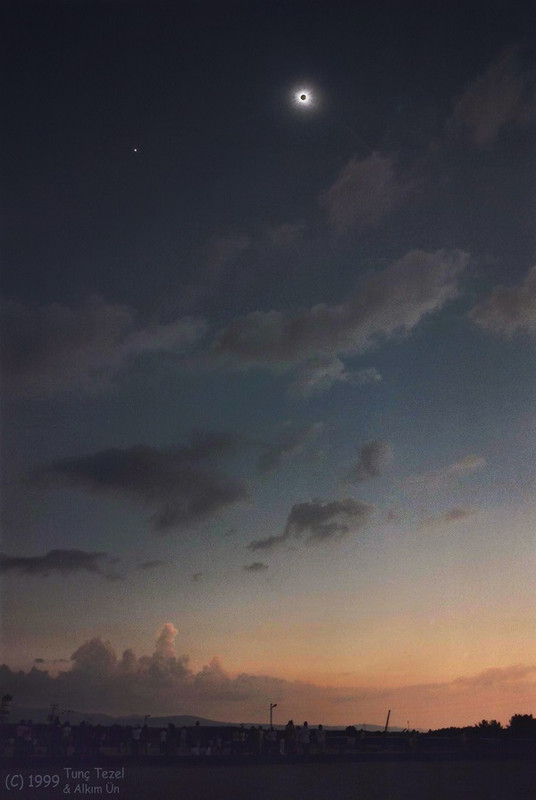
A Total Solar Eclipse of Saros 145
Image Credit & Copyright: Tunç Tezel (TWAN), Alkim Ün
Explanation: A darkened sky holds bright planet Venus, the New Moon in silhouette, and the shimmering corona of the Sun in this image of a total solar eclipse. A composite of simultaneous telephoto and wide angle frames it was taken in the path of totality 18 years ago, August 11, 1999, near Kastamonu, Turkey. That particular solar eclipse is a member of Saros 145. Known historically from observations of the Moon's orbit, the Saros cycle predicts when the Sun, Earth, and Moon will return to the same geometry for a solar (or lunar) eclipse. The Saros has a period of 18 years, 11 and 1/3 days. Eclipses separated by one Saros period belong to the same numbered Saros series and are very similar. But the path of totality for consecutive solar eclipses in the same Saros shifts across the Earth because the planet rotates for an additional 8 hours during the cycle's fractional day. So the next solar eclipse of Saros 145 will also be a total eclipse, and the narrow path of totality will track coast to coast across the United States on August 21, 2017.

A Total Solar Eclipse of Saros 145
Image Credit & Copyright: Tunç Tezel (TWAN), Alkim Ün
Explanation: A darkened sky holds bright planet Venus, the New Moon in silhouette, and the shimmering corona of the Sun in this image of a total solar eclipse. A composite of simultaneous telephoto and wide angle frames it was taken in the path of totality 18 years ago, August 11, 1999, near Kastamonu, Turkey. That particular solar eclipse is a member of Saros 145. Known historically from observations of the Moon's orbit, the Saros cycle predicts when the Sun, Earth, and Moon will return to the same geometry for a solar (or lunar) eclipse. The Saros has a period of 18 years, 11 and 1/3 days. Eclipses separated by one Saros period belong to the same numbered Saros series and are very similar. But the path of totality for consecutive solar eclipses in the same Saros shifts across the Earth because the planet rotates for an additional 8 hours during the cycle's fractional day. So the next solar eclipse of Saros 145 will also be a total eclipse, and the narrow path of totality will track coast to coast across the United States on August 21, 2017.

panosol- Αριθμός μηνυμάτων : 762
Points : 927
Reputation : 15
Ημερομηνία εγγραφής : 17/06/2012
Ηλικία : 56
 2017 August 21
2017 August 21
2017 August 21
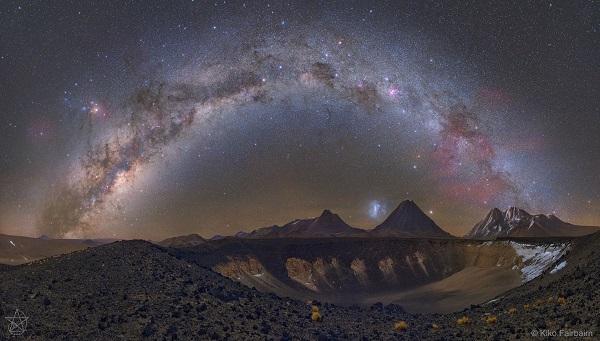
Milky Way over Chilean Volcanoes
Image Credit & Copyright: Carlos Eduardo Fairbairn
Explanation: Sometimes, the sky mimics the ground. Taken in 2017 May from the Atacama Desert in Chile, the foreground of the featured image encompasses the dipping edge of the caldera of an extinct volcano. Poetically echoing the dip below is the arch of our Milky Way Galaxy above. Many famous icons dot this southern nighttime vista, including the center of our Milky Way Galaxy on the far left, the bright orange star Antares also on the left, the constellation of the Southern Cross near the top of the arch, and the red-glowing Gum Nebula on the far right. Just above the horizon and splitting two distant volcanic peaks near the image center is the Large Magellanic Cloud -- the largest satellite galaxy of the Milky Way.

Milky Way over Chilean Volcanoes
Image Credit & Copyright: Carlos Eduardo Fairbairn
Explanation: Sometimes, the sky mimics the ground. Taken in 2017 May from the Atacama Desert in Chile, the foreground of the featured image encompasses the dipping edge of the caldera of an extinct volcano. Poetically echoing the dip below is the arch of our Milky Way Galaxy above. Many famous icons dot this southern nighttime vista, including the center of our Milky Way Galaxy on the far left, the bright orange star Antares also on the left, the constellation of the Southern Cross near the top of the arch, and the red-glowing Gum Nebula on the far right. Just above the horizon and splitting two distant volcanic peaks near the image center is the Large Magellanic Cloud -- the largest satellite galaxy of the Milky Way.

panosol- Αριθμός μηνυμάτων : 762
Points : 927
Reputation : 15
Ημερομηνία εγγραφής : 17/06/2012
Ηλικία : 56
 2017 August 22
2017 August 22
2017 August 22

A Total Solar Eclipse over Wyoming
Image Credit & Copyright: Ben Cooper
Explanation: Will the sky be clear enough to see the eclipse? This question was on the minds of many people attempting to view yesterday's solar eclipse. The path of total darkness crossed the mainland of the USA from coast to coast, from Oregon to South Carolina -- but a partial eclipse occurred above all of North America. Unfortunately, many locations saw predominantly clouds. One location that did not was a bank of Green River Lake, Wyoming. There, clouds blocked the Sun intermittantly up to one minute before totality. Parting clouds then moved far enough away to allow the center image of the featured composite sequence to be taken. This image shows the corona of the Sun extending out past the central dark Moon that blocks our familiar Sun. The surrounding images show the partial phases of the solar eclipse both before and after totality.

A Total Solar Eclipse over Wyoming
Image Credit & Copyright: Ben Cooper
Explanation: Will the sky be clear enough to see the eclipse? This question was on the minds of many people attempting to view yesterday's solar eclipse. The path of total darkness crossed the mainland of the USA from coast to coast, from Oregon to South Carolina -- but a partial eclipse occurred above all of North America. Unfortunately, many locations saw predominantly clouds. One location that did not was a bank of Green River Lake, Wyoming. There, clouds blocked the Sun intermittantly up to one minute before totality. Parting clouds then moved far enough away to allow the center image of the featured composite sequence to be taken. This image shows the corona of the Sun extending out past the central dark Moon that blocks our familiar Sun. The surrounding images show the partial phases of the solar eclipse both before and after totality.

panosol- Αριθμός μηνυμάτων : 762
Points : 927
Reputation : 15
Ημερομηνία εγγραφής : 17/06/2012
Ηλικία : 56
 2017 August 23
2017 August 23
2017 August 23
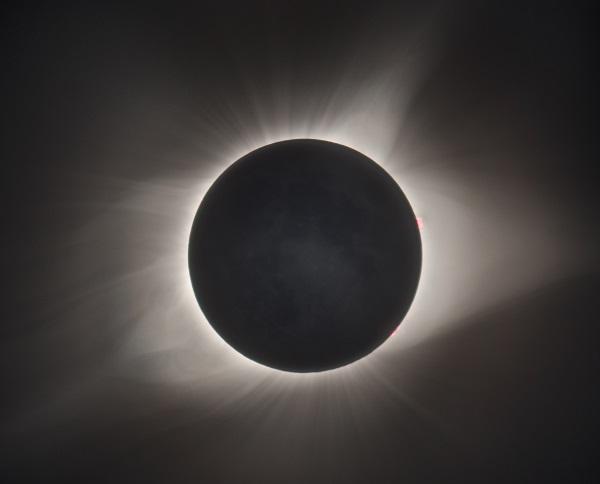
The Crown of the Sun
Image Credit & Copyright: Derek Demeter (Emil Buehler Planetarium)
Explanation: During a total solar eclipse, the Sun's extensive outer atmosphere, or corona, is an inspirational sight. Streamers and shimmering features visible to the eye span a brightness range of over 10,000 to 1, making them notoriously difficult to capture in a single photograph. But this composite of telescopic images covers a wide range of exposure times to reveal the crown of the Sun in all its glory. The aligned and stacked digital frames were taken in clear skies above Stanley, Idaho in the Sawtooth Mountains during the Sun's total eclipse on August 21. A pinkish solar prominence extends just beyond the right edge of the solar disk. Even small details on the dark night side of the New Moon can be made out, illuminated by sunlight reflected from a Full Earth.

The Crown of the Sun
Image Credit & Copyright: Derek Demeter (Emil Buehler Planetarium)
Explanation: During a total solar eclipse, the Sun's extensive outer atmosphere, or corona, is an inspirational sight. Streamers and shimmering features visible to the eye span a brightness range of over 10,000 to 1, making them notoriously difficult to capture in a single photograph. But this composite of telescopic images covers a wide range of exposure times to reveal the crown of the Sun in all its glory. The aligned and stacked digital frames were taken in clear skies above Stanley, Idaho in the Sawtooth Mountains during the Sun's total eclipse on August 21. A pinkish solar prominence extends just beyond the right edge of the solar disk. Even small details on the dark night side of the New Moon can be made out, illuminated by sunlight reflected from a Full Earth.

panosol- Αριθμός μηνυμάτων : 762
Points : 927
Reputation : 15
Ημερομηνία εγγραφής : 17/06/2012
Ηλικία : 56
 2017 August 24
2017 August 24
2017 August 24
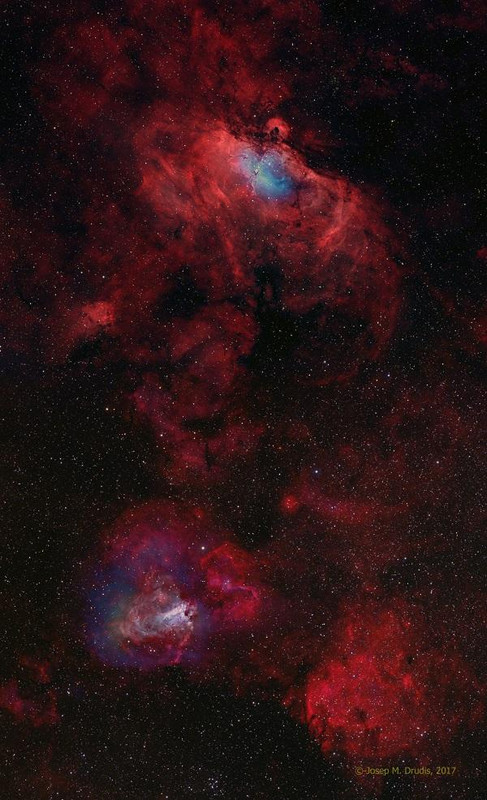
The Eagle and The Swan
Image Credit & Copyright: Josep Drudis
Explanation: The Eagle Nebula and the Swan Nebula span this broad starscape, a telescopic view toward the Sagittarius spiral arm and the center of our Milky Way galaxy. The Eagle, also known as M16, is at top and M17, the Swan, at bottom of the frame showing the cosmic clouds as brighter regions of active star-formation. They lie along the spiral arm suffused with reddish emission charactistic of atomic hydrogen gas, and dusty dark nebulae. M17, also called the Omega Nebula, is about 5500 light-years away, while M16 is some 6500 light-years distant. The center of both nebulae are locations of well-known close-up images of star formation from the Hubble Space Telescope. In this mosaic image that extends about 3 degrees across the sky, narrowband, high-resultion image data has been used to enhance the central regions of the Eagle and Swan. The extended wings of the Eagle Nebula spread almost 120 light-years. The Swan is over 30 light-years across.

The Eagle and The Swan
Image Credit & Copyright: Josep Drudis
Explanation: The Eagle Nebula and the Swan Nebula span this broad starscape, a telescopic view toward the Sagittarius spiral arm and the center of our Milky Way galaxy. The Eagle, also known as M16, is at top and M17, the Swan, at bottom of the frame showing the cosmic clouds as brighter regions of active star-formation. They lie along the spiral arm suffused with reddish emission charactistic of atomic hydrogen gas, and dusty dark nebulae. M17, also called the Omega Nebula, is about 5500 light-years away, while M16 is some 6500 light-years distant. The center of both nebulae are locations of well-known close-up images of star formation from the Hubble Space Telescope. In this mosaic image that extends about 3 degrees across the sky, narrowband, high-resultion image data has been used to enhance the central regions of the Eagle and Swan. The extended wings of the Eagle Nebula spread almost 120 light-years. The Swan is over 30 light-years across.

panosol- Αριθμός μηνυμάτων : 762
Points : 927
Reputation : 15
Ημερομηνία εγγραφής : 17/06/2012
Ηλικία : 56
 2017 August 25
2017 August 25
2017 August 25
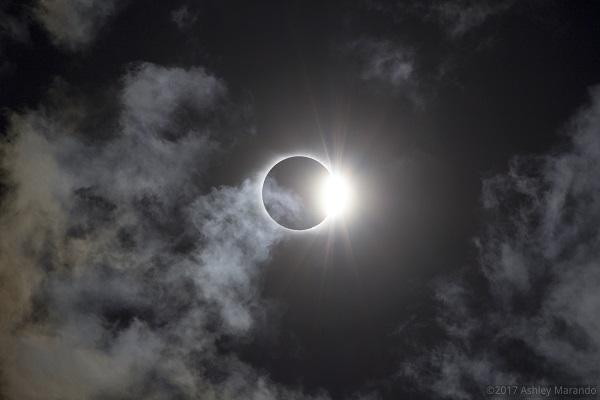
Diamond Ring in a Cloudy Sky
Image Credit & Copyright: Ashley Marando
Explanation: As the Moon's shadow swept across the US on August 21, eclipse chasers in the narrow path of totality were treated to a diamond ring in the sky. At the beginning and end of totality, the fleeting and beautiful effect often produces audible gasps from an amazed audience. It occurs just before or after the appearance of the faint solar corona with a brief ring of light and glimpse of Sun. In this scene from the end of totality at Central, South Carolina, clouds drift near the Sun's diamond ring in the sky.

Diamond Ring in a Cloudy Sky
Image Credit & Copyright: Ashley Marando
Explanation: As the Moon's shadow swept across the US on August 21, eclipse chasers in the narrow path of totality were treated to a diamond ring in the sky. At the beginning and end of totality, the fleeting and beautiful effect often produces audible gasps from an amazed audience. It occurs just before or after the appearance of the faint solar corona with a brief ring of light and glimpse of Sun. In this scene from the end of totality at Central, South Carolina, clouds drift near the Sun's diamond ring in the sky.

panosol- Αριθμός μηνυμάτων : 762
Points : 927
Reputation : 15
Ημερομηνία εγγραφής : 17/06/2012
Ηλικία : 56
 2017 August 26
2017 August 26
2017 August 26
Hurricane Harvey Strengthens
Video Credit: NASA-NOAA GOES Project
Explanation: A large and dangerous hurricane has developed in the Gulf of Mexico. The featured time-lapse video shows Hurricane Harvey growing to Category 4 strength over the past few days, as captured by NASA and NOAA's GOES-East satellite. Starting as a slight dip in air pressure, hurricanes swell into expansive spiraling storm systems, complete with high winds and driving rain. Hurricanes are powered by evaporating ocean water, and so typically gain strength over warm water and lose strength over land. Much remains unknown about hurricanes and cyclones, including details of how they are formed and the exact path they will take. Hurricane Harvey, accompanied by a dangerous storm surge, is expected to make landfall sometime today in Texas.
Hurricane Harvey Strengthens
Video Credit: NASA-NOAA GOES Project
Explanation: A large and dangerous hurricane has developed in the Gulf of Mexico. The featured time-lapse video shows Hurricane Harvey growing to Category 4 strength over the past few days, as captured by NASA and NOAA's GOES-East satellite. Starting as a slight dip in air pressure, hurricanes swell into expansive spiraling storm systems, complete with high winds and driving rain. Hurricanes are powered by evaporating ocean water, and so typically gain strength over warm water and lose strength over land. Much remains unknown about hurricanes and cyclones, including details of how they are formed and the exact path they will take. Hurricane Harvey, accompanied by a dangerous storm surge, is expected to make landfall sometime today in Texas.

panosol- Αριθμός μηνυμάτων : 762
Points : 927
Reputation : 15
Ημερομηνία εγγραφής : 17/06/2012
Ηλικία : 56
 2017 August 27
2017 August 27
2017 August 27
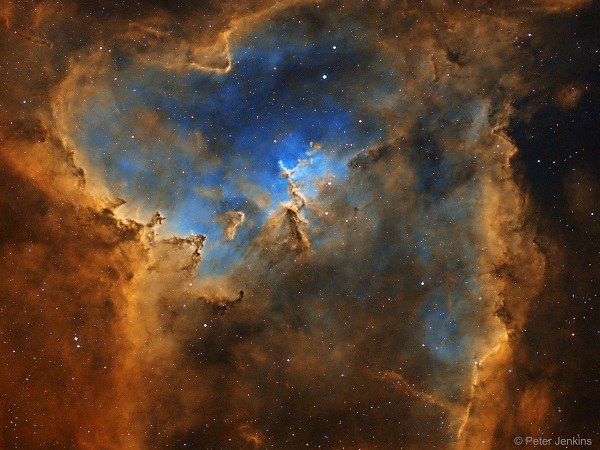
The Heart Nebula in Hydrogen, Oxygen, and Sulfur
Image Credit & Copyright: Peter Jenkins
Explanation: What powers the Heart Nebula? The large emission nebula dubbed IC 1805 looks, in whole, like a heart. The nebula's glow -- as well as the shape of the gas and dust clouds -- is powered by by stellar winds and radiation from massive hot stars in the nebula's newborn star cluster Melotte 15. This deep telescopic image maps the pervasive light of narrow emission lines from atoms of hydrogen, oxygen, and sulfur in the nebula. The field of view spans just over two degrees on the sky, so that it appears larger than four times the diameter of a full moon. The cosmic heart is found in the constellation of Cassiopeia, the boastful mythical Queen of Aethiopia .

The Heart Nebula in Hydrogen, Oxygen, and Sulfur
Image Credit & Copyright: Peter Jenkins
Explanation: What powers the Heart Nebula? The large emission nebula dubbed IC 1805 looks, in whole, like a heart. The nebula's glow -- as well as the shape of the gas and dust clouds -- is powered by by stellar winds and radiation from massive hot stars in the nebula's newborn star cluster Melotte 15. This deep telescopic image maps the pervasive light of narrow emission lines from atoms of hydrogen, oxygen, and sulfur in the nebula. The field of view spans just over two degrees on the sky, so that it appears larger than four times the diameter of a full moon. The cosmic heart is found in the constellation of Cassiopeia, the boastful mythical Queen of Aethiopia .

panosol- Αριθμός μηνυμάτων : 762
Points : 927
Reputation : 15
Ημερομηνία εγγραφής : 17/06/2012
Ηλικία : 56
 2017 August 28
2017 August 28
2017 August 28

A Fleeting Double Eclipse of the Sun
Image Credit & Copyright: Simon Tang
Explanation: Last week, for a fraction of a second, the Sun was eclipsed twice. One week ago today, many people in North America were treated to a standard, single, partial solar eclipse. Fewer people, all congregated along a narrow path, experienced the eerie daytime darkness of a total solar eclipse. A dedicated few with fast enough camera equipment, however, were able to capture a double eclipse -- a simultaneous partial eclipse of the Sun by both the Moon and the International Space Station (ISS). The Earth-orbiting ISS crossed the Sun in less than a second, but to keep the ISS from appearing blurry, exposure times must be less than 1/1000th of a second. The featured image composite captured the ISS multiple times in succession as it zipped across the face of the Sun. The picture was taken in a specific color emitted by hydrogen which highlights the Sun's chromosphere, a layer hotter and higher up than the usually photographed photosphere.

A Fleeting Double Eclipse of the Sun
Image Credit & Copyright: Simon Tang
Explanation: Last week, for a fraction of a second, the Sun was eclipsed twice. One week ago today, many people in North America were treated to a standard, single, partial solar eclipse. Fewer people, all congregated along a narrow path, experienced the eerie daytime darkness of a total solar eclipse. A dedicated few with fast enough camera equipment, however, were able to capture a double eclipse -- a simultaneous partial eclipse of the Sun by both the Moon and the International Space Station (ISS). The Earth-orbiting ISS crossed the Sun in less than a second, but to keep the ISS from appearing blurry, exposure times must be less than 1/1000th of a second. The featured image composite captured the ISS multiple times in succession as it zipped across the face of the Sun. The picture was taken in a specific color emitted by hydrogen which highlights the Sun's chromosphere, a layer hotter and higher up than the usually photographed photosphere.

panosol- Αριθμός μηνυμάτων : 762
Points : 927
Reputation : 15
Ημερομηνία εγγραφής : 17/06/2012
Ηλικία : 56
 2017 August 29
2017 August 29
2017 August 29
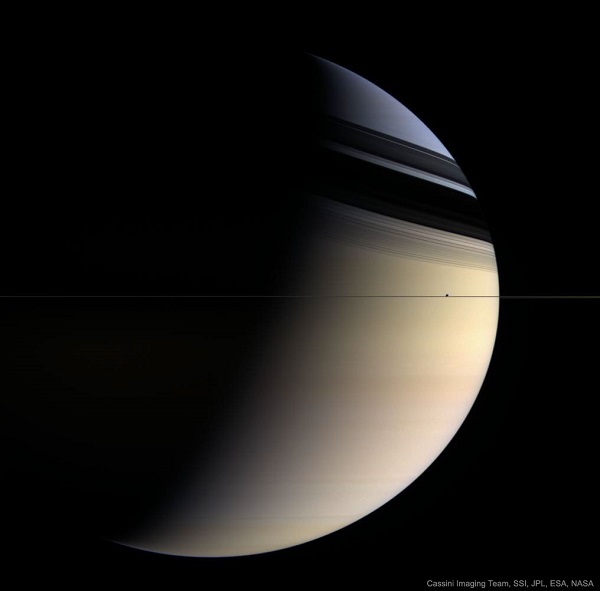
Saturn in Blue and Gold
Image Credit: Cassini Imaging Team, SSI, JPL, ESA, NASA
Explanation: Why is Saturn partly blue? The featured picture of Saturn approximates what a human would see if hovering close to the giant ringed world. The image was taken in 2006 March by the robot Cassini spacecraft now orbiting Saturn. Here Saturn's majestic rings appear directly only as a thin vertical line. The rings show their complex structure in the dark shadows they create on the image left. Saturn's fountain moon Enceladus, only about 500 kilometers across, is seen as the bump in the plane of the rings. The northern hemisphere of Saturn can appear partly blue for the same reason that Earth's skies can appear blue -- molecules in the cloudless portions of both planet's atmospheres are better at scattering blue light than red. When looking deep into Saturn's clouds, however, the natural gold hue of Saturn's clouds becomes dominant. It is not known why southern Saturn does not show the same blue hue -- one hypothesis holds that clouds are higher there. It is also not known why Saturn's clouds are colored gold. Next month, Cassini will end its mission with a final dramatic dive into Saturn's atmosphere.

Saturn in Blue and Gold
Image Credit: Cassini Imaging Team, SSI, JPL, ESA, NASA
Explanation: Why is Saturn partly blue? The featured picture of Saturn approximates what a human would see if hovering close to the giant ringed world. The image was taken in 2006 March by the robot Cassini spacecraft now orbiting Saturn. Here Saturn's majestic rings appear directly only as a thin vertical line. The rings show their complex structure in the dark shadows they create on the image left. Saturn's fountain moon Enceladus, only about 500 kilometers across, is seen as the bump in the plane of the rings. The northern hemisphere of Saturn can appear partly blue for the same reason that Earth's skies can appear blue -- molecules in the cloudless portions of both planet's atmospheres are better at scattering blue light than red. When looking deep into Saturn's clouds, however, the natural gold hue of Saturn's clouds becomes dominant. It is not known why southern Saturn does not show the same blue hue -- one hypothesis holds that clouds are higher there. It is also not known why Saturn's clouds are colored gold. Next month, Cassini will end its mission with a final dramatic dive into Saturn's atmosphere.

panosol- Αριθμός μηνυμάτων : 762
Points : 927
Reputation : 15
Ημερομηνία εγγραφής : 17/06/2012
Ηλικία : 56
 2017 August 30
2017 August 30
2017 August 30

Panoramic Eclipse Composite with Star Trails
Image Credit & Copyright: Stephane Vetter (Nuits sacrees, TWAN)
Explanation: What was happening in the sky during last week's total solar eclipse? This featured little-planet, all-sky, double time-lapse, digitally-fused composite captured celestial action during both night and day from a single location. In this 360x180 panorama, north and south are at the image bottom and top, while east and west are at the left and right edges, respectively. During four hours the night before the eclipse, star trails were captured circling the north celestial pole (bottom) as the Earth spun. During the day of the total eclipse, the Sun was captured every fifteen minutes from sunrise to sunset (top), sometimes in partial eclipse. All of these images were then digitally merged onto a single image taken exactly during the total solar eclipse. Then, the Sun's bright corona could be seen flaring around the dark new Moon (upper left), while Venus simultaneously became easily visible (top). The tree in the middle, below the camera, is a Douglas fir. The images were taken with care and planning at Magone Lake in Oregon, USA.

Panoramic Eclipse Composite with Star Trails
Image Credit & Copyright: Stephane Vetter (Nuits sacrees, TWAN)
Explanation: What was happening in the sky during last week's total solar eclipse? This featured little-planet, all-sky, double time-lapse, digitally-fused composite captured celestial action during both night and day from a single location. In this 360x180 panorama, north and south are at the image bottom and top, while east and west are at the left and right edges, respectively. During four hours the night before the eclipse, star trails were captured circling the north celestial pole (bottom) as the Earth spun. During the day of the total eclipse, the Sun was captured every fifteen minutes from sunrise to sunset (top), sometimes in partial eclipse. All of these images were then digitally merged onto a single image taken exactly during the total solar eclipse. Then, the Sun's bright corona could be seen flaring around the dark new Moon (upper left), while Venus simultaneously became easily visible (top). The tree in the middle, below the camera, is a Douglas fir. The images were taken with care and planning at Magone Lake in Oregon, USA.

panosol- Αριθμός μηνυμάτων : 762
Points : 927
Reputation : 15
Ημερομηνία εγγραφής : 17/06/2012
Ηλικία : 56
 2017 August 31
2017 August 31
2017 August 31

Lunar View, Solar Eclipse
Image Credit: NASA / GSFC / Arizona State Univ. / Lunar Reconnaissance Orbiter
Explanation: Orbiting above the lunar nearside on August 21, the Lunar Reconnaissance Orbiter turned to look back on a bright, Full Earth. As anticipated its Narrow Angle Camera scanned this sharp view of our fair planet, catching the shadow of the Moon racing along a path across the United States at about 1,500 miles per hour. In fact, the dark lunar shadow is centered over Hopkinsville, Kentucky at 1:25:30 Central Daylight Time. From there, the New Moon blocked the Sun high in clear skies for about 2 minutes and 40 seconds in a total solar eclipse.

Lunar View, Solar Eclipse
Image Credit: NASA / GSFC / Arizona State Univ. / Lunar Reconnaissance Orbiter
Explanation: Orbiting above the lunar nearside on August 21, the Lunar Reconnaissance Orbiter turned to look back on a bright, Full Earth. As anticipated its Narrow Angle Camera scanned this sharp view of our fair planet, catching the shadow of the Moon racing along a path across the United States at about 1,500 miles per hour. In fact, the dark lunar shadow is centered over Hopkinsville, Kentucky at 1:25:30 Central Daylight Time. From there, the New Moon blocked the Sun high in clear skies for about 2 minutes and 40 seconds in a total solar eclipse.

panosol- Αριθμός μηνυμάτων : 762
Points : 927
Reputation : 15
Ημερομηνία εγγραφής : 17/06/2012
Ηλικία : 56
 2017 September 1
2017 September 1
2017 September 1
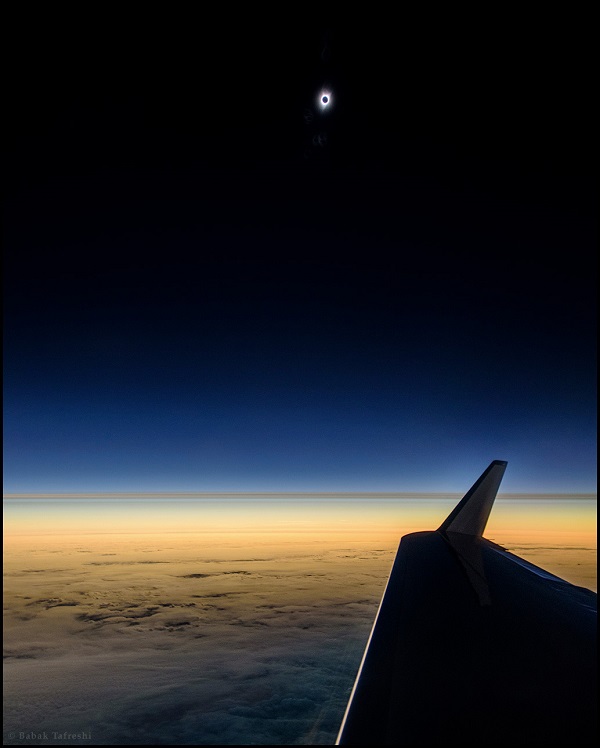
A First Glimpse of the Great American Eclipse
Image Credit & Copyright: Babak Tafreshi (TWAN), National Geographic
Explanation: Making landfall in Oregon, the Moon's dark umbral shadow toured the United States on August 21. Those gathered along its coast to coast path were witness to a total eclipse of the Sun, possibly the most widely shared celestial event in history. But first, the Moon's shadow touched the northern Pacific and raced eastward toward land. This dramatic snapshot was taken while crossing the shadow path 250 miles off the Oregon coast, 45,000 feet above the cloudy northern Pacific. Though from a shorter totality, it captures the eclipse before it could be seen from the US mainland. With the eclipsed Sun not far above, beautiful colors appear along the western horizon giving way to a clear, pitch-black, stratospheric sky in the shadow of the Moon.

A First Glimpse of the Great American Eclipse
Image Credit & Copyright: Babak Tafreshi (TWAN), National Geographic
Explanation: Making landfall in Oregon, the Moon's dark umbral shadow toured the United States on August 21. Those gathered along its coast to coast path were witness to a total eclipse of the Sun, possibly the most widely shared celestial event in history. But first, the Moon's shadow touched the northern Pacific and raced eastward toward land. This dramatic snapshot was taken while crossing the shadow path 250 miles off the Oregon coast, 45,000 feet above the cloudy northern Pacific. Though from a shorter totality, it captures the eclipse before it could be seen from the US mainland. With the eclipsed Sun not far above, beautiful colors appear along the western horizon giving way to a clear, pitch-black, stratospheric sky in the shadow of the Moon.

panosol- Αριθμός μηνυμάτων : 762
Points : 927
Reputation : 15
Ημερομηνία εγγραφής : 17/06/2012
Ηλικία : 56
 2017 September 2
2017 September 2
2017 September 2
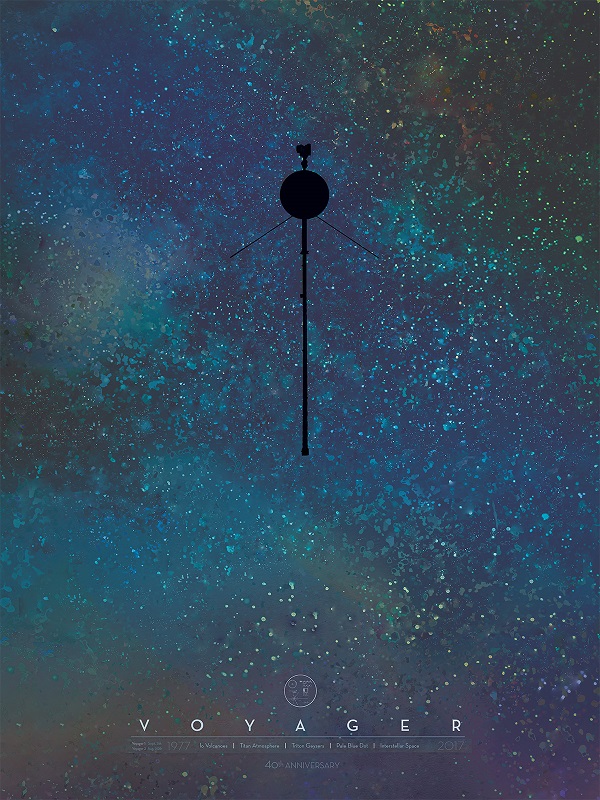
Milky Way Voyager
Poster Illustration Credit: NASA, JPL-Caltech, Voyager
Explanation: Launched in 1977 on a tour of the outer planets of the Solar System, Voyager 1 and 2 have become the longest operating and most distant spacecraft from Earth. Nearly 16 light-hours from the Sun, Voyager 2 has reached the edge of the heliosphere, the realm defined by the influence of the solar wind and the Sun's magnetic field. Now humanity's first ambassador to the Milky Way, Voyager 1 is over 19 light-hours away, beyond the heliosphere in interstellar space. Celebrate the Voyagers' 40 year journey toward the stars with NASA on September 5.

Milky Way Voyager
Poster Illustration Credit: NASA, JPL-Caltech, Voyager
Explanation: Launched in 1977 on a tour of the outer planets of the Solar System, Voyager 1 and 2 have become the longest operating and most distant spacecraft from Earth. Nearly 16 light-hours from the Sun, Voyager 2 has reached the edge of the heliosphere, the realm defined by the influence of the solar wind and the Sun's magnetic field. Now humanity's first ambassador to the Milky Way, Voyager 1 is over 19 light-hours away, beyond the heliosphere in interstellar space. Celebrate the Voyagers' 40 year journey toward the stars with NASA on September 5.

panosol- Αριθμός μηνυμάτων : 762
Points : 927
Reputation : 15
Ημερομηνία εγγραφής : 17/06/2012
Ηλικία : 56
Σελίδα 10 από 15 •  1 ... 6 ... 9, 10, 11 ... 15
1 ... 6 ... 9, 10, 11 ... 15 
Σελίδα 10 από 15
Δικαιώματα σας στην κατηγορία αυτή
Δεν μπορείτε να απαντήσετε στα Θέματα αυτής της Δ.Συζήτησης|
|
|

 Αρχική
Αρχική Φόρουμ
Φόρουμ RADIO
RADIO ΠΑΙΓΝΙΔΙΑ
ΠΑΙΓΝΙΔΙΑ Latest images
Latest images Εγγραφή
Εγγραφή Σύνδεση
Σύνδεση




» ΚΑΛΗ ΑΝΑΣΤΑΣΗ ΚΑΙ ΚΑΛΟ ΠΑΣΧΑ!!
» Εφυγε από τη ζωή ο Τζίμης Πανούσης
» ΧΡΟΝΙΑ ΠΟΛΛΑ ΚΑΙ ΚΑΛΗ ΧΡΟΝΙΑ ΜΕ ΥΓΕΙΑ ΚΑΙ ΕΥΤΥΧΙΑ!!!
» This day in music
» Astronomy Picture of the Day
» Τις καλύτερες ευχές μου για Ευτυχισμένα Χριστούγεννα σε όλους!!
» ΖΗΤΩ Η 28η ΟΚΤΩΒΡΙΟΥ 1940
» ΖΗΤΩ Η 28η ΟΚΤΩΒΡΙΟΥ 1940
» Το τελευταίο αντίο στη Ζωή Λάσκαρη
» 19 Μαΐου: Ημέρα Μνήμης της Γενοκτονίας των Ποντίων
» Kαλό σου ταξίδι!!
» ΧΡΙΣΤΟΣ ΑΝΕΣΤΗ!!
» ΚΑΛΗ ΜΕΓΑΛΗ ΕΒΔΟΜΑΔΑ!!
» ΚΑΛΟ ΜΗΝΑ!!!
» ΧΡΟΝΙΑ ΠΟΛΛΑ!!
» ΧΡΟΝΙΑ ΠΟΛΛΑ!!
» R.I.P. Chuck Berry
» 8 Μαρτίου - Παγκόσμια Ημέρα της Γυναίκας
» ΧΡΟΝΙΑ ΠΟΛΛΑ ΚΑΙ ΚΑΛΗ ΣΑΡΑΚΟΣΤΗ!!